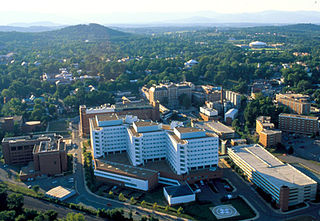
Charlottesville, colloquially known as C'ville, is an independent city in the Commonwealth of Virginia. It is the county seat of Albemarle County, which surrounds the city, though the two are separate legal entities. It is named after Queen Charlotte. As of the 2020 census, the population was 46,553. The Bureau of Economic Analysis combines the City of Charlottesville with Albemarle County for statistical purposes, bringing its population to approximately 150,000. Charlottesville is the heart of the Charlottesville metropolitan area, which includes Albemarle, Buckingham, Fluvanna, Greene, and Nelson counties.

Park Place is a neighborhood in the western half of Norfolk, Virginia. Its boundaries are roughly Granby Street on the east, Colley Avenue on the west, 23rd Street on the south and up to 38th Street to the north. Within these boundaries Park Place is made up of 4 historic subdivisions; Virginia Place, East Kensington, Park Place, and East Old Dominion Place.

The Confederate Monument in Portsmouth, Virginia, was built between 1876 and 1881. It was listed on the National Register of Historic Places (NRHP) in 1997.

Delevan Baptist Church, also known as First Baptist Church and First Colored Baptist Church, is a historic African-American Baptist church building located at 632 W. Main Street in Charlottesville, Virginia. It was built in 1883, and is a one-story, three bay by six bay, Victorian Romanesque style brick church. It sits on a raised basement and features with a square projecting central tower topped by a large octagonal lantern on a square base, both of wood.

Ashton Heights Historic District is a national historic district located in Arlington County, Virginia. Today, the Ashton Height Historic District contains 1,097 contributing buildings, one contributing site, and one contributing structure in a residential neighborhood in North Arlington.
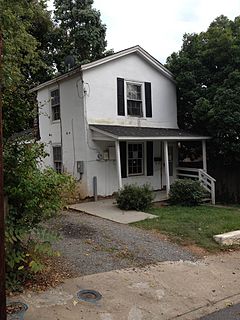
Gardner–Mays Cottage is a historic home located at Charlottesville, Virginia. It was built in 1891, and is a one-over-one-room stucco cottage on a low foundation with an original one-room rear wing. The house is typical of the many small worker's cottages built in Fifeville.
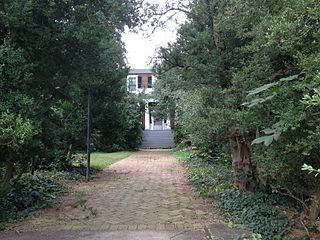
Locust Grove is a historic home located at Charlottesville, Virginia. It was built between 1840 and 1844, and is a two-story, five-bay, Georgian style brick dwelling. It has a hipped roof and end chimneys. On the front facade is a portico with coupled paneled columns. Also on the property are a contributing original kitchen and smokehouse.
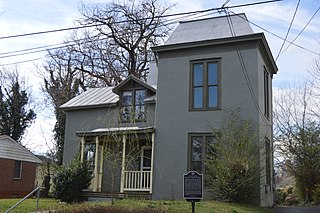
Benjamin Tonsler House is a historic home located at Charlottesville, Virginia. It was built in 1879, and is a two-story, stuccoed frame Late Victorian dwelling with elements of the Italianate and Second Empire styles. It has a rear wing, high-pitched gable roof, and a projecting corner tower with a mansard roof.

The Marshall–Rucker–Smith House is a historic home located at Charlottesville, Virginia. It was built for J. William and Carrie Marshall in 1894 by William T. Vandegrift, the grandfather of General Alexander Archer Vandegrift, and is a two-story, nearly square, Queen Anne style brick dwelling. It has a three-story octagonal corner tower, a prominent front gable projection of the slate-shingled hip roof, a two-story rear wing, and multiple one-story porches. A two-story solarium and library wing were added by its second owner, William J. Rucker in about 1930. Also on the property is a contributing swimming pool which is now used as a members-only neighborhood pool. In the mid-20th century, after the house had been made into a rooming house, future Supreme Court Justice Sandra Day O'Connor numbered among its residents while her husband was attending the Judge Advocate General School at the University of Virginia School of Law.
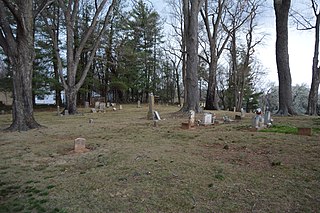
Daughters of Zion Cemetery, also known as Zion Cemetery, Society Cemetery, and Old Oakwood Section, is a historic African-American cemetery located at Charlottesville, Virginia. It was established in 1873, and contains an estimated 300 burial sites with 152 of the burials commemorated with 136 surviving grave markers. It consists exclusively of marble and granite grave markers with a single 20 foot by 20 foot section enclosed with a cast-iron fence. Notable burials include Benjamin Tonsler (1854-1917), who built the Benjamin Tonsler House. The city assumed title to the property in the 1970s, and the last burial occurred in 1995.

Oak Lawn is a historic home located at Charlottesville, Virginia. The brick dwelling was built in 1822, and consists of a two-story, four bay, main block flanked by one-story, two bay wings. The central section has a front gable roof and one-story porch with a flat roof supported by four Tuscan order columns and topped by a second story balcony. Exterior chimneys arise between the main block and each of the wings. Also on the property are a contributing kitchen (1822) and two cemeteries. It was built by James Dinsmore, a Scots-Irish builder who worked for Thomas Jefferson.

Albemarle County Courthouse Historic District is a historic courthouse and national historic district located at Charlottesville, Virginia. The district encompasses 22 contributing buildings and 1 contributing object centered on Court Square. The original section of the courthouse was built in 1803 in the Federal style and is now the north wing. The courthouse is a two-story, five-bay, "T" shaped brick building with a Greek Revival style portico. Other notable buildings include the Levy Opera House, Number Nothing, Redland Club, and Eagle Tavern.

Charlottesville and Albemarle County Courthouse Historic District, also known as the Charlottesville Historic District is a national historic district located at Charlottesville, Virginia. The district encompasses the previously listed Albemarle County Courthouse Historic District and includes 269 contributing buildings and 1 contributing object in the city of Charlottesville. It includes the traditional heart of the city's commercial, civic, and religious activities, with early residential development and industrial sites located along the fringe. The commercial core is located along a seven block Downtown Mall designed by Lawrence Halprin (1916-2009). Notable buildings include the Albemarle County Courthouse, Levy Opera House, Number Nothing, Redland Club, Eagle Tavern, United States Post Office and Courts Building (1906), Christ (Episcopal) Church (1895-1898), Beth Israel Synagogue (1882-1903), Holy Comforter Catholic Church (1925), First Methodist Church (1924), McIntire Public Library (1919-1922), and Virginia National Bank (1916). Also located in the district are the separately listed Abell-Gleason House, William H. McGuffey Primary School, Thomas Jonathan Jackson sculpture, Robert Edward Lee sculpture, and Marshall-Rucker-Smith House.

Rugby Road–University Corner Historic District is a national historic district located at Charlottesville, Virginia. The district encompasses 173 contributing buildings in the city of Charlottesville. It includes a variety of commercial, residential, and institutional structures mirroring the University of Virginia's development between the 1890s and the Great Depression. It includes properties on Carr's Hill. Notable buildings include the Chancellor Building (1920), the Minor Court Building, Mincer's Shop Building 1920s), the Stevens-Shepherd Building, Buckingham Palace, St. Paul's Episcopal Church (1926–27), Madison Hall (1905), fraternity houses dating from 1902 to 1928, Fayerweather Hall (1893), the Bayly Museum (1934), Faculty Apartments building, Watts-Hillel House (1913-1914), and Hotopp-Watson House (1900). Also located in the district are the separately listed Anderson Brothers Building, Preston Court Apartments, and Wynhurst.
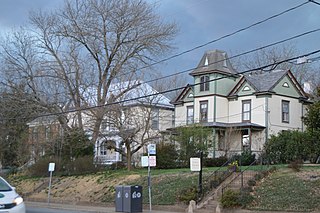
Ridge Street Historic District is a national historic district located at Charlottesville, Virginia. The district encompasses 32 contributing buildings in a four block residential section of the city of Charlottesville. It was primarily developed after the 1870s-1880s. Notable buildings include the Gleason House (1890s), Fuller-Bailey House (1892), Clarence L. Hawkins House (1915), Bibb-Wolfe House, Gianny-Bailey House (1895), Walters-Witkin House, and Colonel John B. Strange House (1855).

Wertland Street Historic District is a national historic district located at Charlottesville, Virginia. The district encompasses 25 contributing buildings in a two block residential section of the city of Charlottesville. It was primarily developed starting in the 1880s. Notable buildings include the Wertenbaker House, McKennie-Miller House, Ward-Brown-Gay House (1889), Marshall-Dabney-Cubbage House (1892), Bryan-Stallings House (1900), and Watson House (1905).

Oakhurst–Gildersleeve Neighborhood Historic District is a national historic district located at Charlottesville, Virginia. The district encompasses 78 contributing buildings in a primarily residential section of the city of Charlottesville. It was developed between 1910 and the 1960s and includes examples of the Bungalow, Colonial Revival, and Tudor Revival styles.
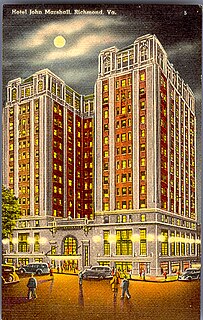
The Grace Street Commercial Historic District is a national historic district located in Richmond, Virginia. The district encompasses 93 contributing buildings located in downtown Richmond. The buildings reflect the core of the city's early 20th-century retail development and the remnants of a 19th-century residential neighborhood. The buildings are in a variety of popular 19th-century and early 20th-century architectural styles, including Classical Revival, Mission Revival, International Style, and Colonial Revival. Notable buildings include the Administration and Equipment Building for the Chesapeake & Potomac Telephone Company (1929), Thalhimer's Department Store, Atlantic Life Building (1950-1959), Miller & Rhoads Department Store, Berry-Burk Building, former W. W. Foster Studios (1927), Bank of Virginia (1949), Investment Realty Company building (1930), W.T. Grant Store (1939), Hotel John Marshall (1927), Franklin Federal Savings and Loan building (1954), and the Tompkins House (1820). Located in the district and separately listed are the Loew's Theatre, Centenary United Methodist Church, Joseph P. Winston House, Central National Bank, and National Theater.
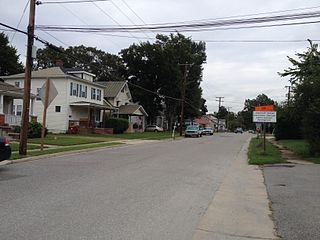
Chesterfield Highlands Historic District is a national historic district located at Colonial Heights, Virginia. The district encompasses 305 contributing buildings and 1 contributing structure. The district was developed in the early decades of the 20th century as a carefully planned middle-class neighborhood in a gridiron plan. The primarily residential district includes dwellings in a variety of popular late 19th and early 20th century architectural styles. Located in the district are the Highland Methodist Episcopal Church (1920), Immanuel Baptist Church (1932), and Colonial Heights Presbyterian Church (1950).

Dominion Hills Historic District is a national historic district located at Arlington County, Virginia. It contains 446 contributing buildings in a residential neighborhood in western Arlington. It was platted in 1942 and developed between 1945 and 1948. It was designed to attract working and middle-income residents and is composed exclusively of two-story Colonial Revival style dwellings.
























